MENU
The Electronic Scholarly Publishing Project: Providing access to classic scientific papers and other scholarly materials, since 1993. More About: ESP | OUR CONTENT | THIS WEBSITE | WHAT'S NEW | WHAT'S HOT
Comparative Timelines
The ESP Timeline (one of the site's most popular features) has been completely updated to allow the user to select (using the timeline controls above each column) different topics for the left and right sides of the display.
Select:
New Left Column
New Left Column
Dates
Decade
New Right Column
New Right Column
Alister Hardy promotes his Homo aquaticus or "aquatic ape" hypothesis to the British Sub Aqua Club. He will follow up this announcement with several magazine articles.
DEC released its first mini computer: PDP-1
1960
 The US flag is modified to have fifty stars, reflecting the addition of one new state: Hawaii.
The US flag is modified to have fifty stars, reflecting the addition of one new state: Hawaii.
The Civil Rights Act of 1960 is signed into law by Pres. Dwight D. Eisenhower on May 6. The act establishes federal inspection of local voter registration rolls and introduces penalties for anyone who obstructs a citizens attempt to register to vote or to cast a ballot.
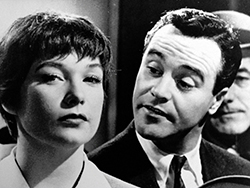 The Apartment wins Academy Award for best picture. After Lost Weekend, Billy Wilder again found himself in the winner's circle, taking home Oscars as producer, director, and co-writer (with I.A.L. Diamond) for this wry look at corporate America.
The Apartment wins Academy Award for best picture. After Lost Weekend, Billy Wilder again found himself in the winner's circle, taking home Oscars as producer, director, and co-writer (with I.A.L. Diamond) for this wry look at corporate America.
Gene Shoemaker and E.C.T. Chao publish a paper characterizing the Ries Basin in Bavaria as the result of a meteorite impact. This will help pave the way for eventual acceptance of asteroid and comet impacts as potential causes of mass extinction.

 F. Jacob and J. Monod publish "Genetic regulatory mechanisms in the synthesis of proteins," a paper in which the theory of the OPERON is developed.
F. Jacob and J. Monod publish "Genetic regulatory mechanisms in the synthesis of proteins," a paper in which the theory of the OPERON is developed.
Martin Glaessner determines fossils in the Ediacara Hills of South Australia (Ediacaran fauna) to be Precambrian in age (approximately 600 million years old), making them the oldest-known multicelled organisms.
Clive Sinclair founds Sinclair Radionics
Computerized spreadsheets for use in business accounting developed
LEO III completed in 1961
Minivac 601 Computer Launched
Robert Noyce Awarded Patent for "Integrated Circuit"
1961
The Congress of Racial Equality organizes Freedom Rides through the Deep South.
 John F. Kennedy becomes thirty-fifth president of the United States.
John F. Kennedy becomes thirty-fifth president of the United States.
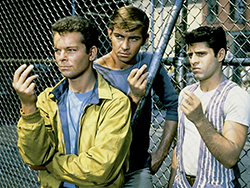 West Side Story wins Academy Award for best picture. The musical was co-directed by Jerome Robbins (who had staged the Broadway musical) and Robert Wise, the first time a team directed a best picture winner. The film won 10 Oscars, remaining in the record books as the sole runner-up to the trio of movies that won 11.
West Side Story wins Academy Award for best picture. The musical was co-directed by Jerome Robbins (who had staged the Broadway musical) and Robert Wise, the first time a team directed a best picture winner. The film won 10 Oscars, remaining in the record books as the sole runner-up to the trio of movies that won 11.
Human geneticist James Neel develops the "thrifty genotype" hypothesis that human ancestors endured feast-famine cycles that made the human body very effective in storing fat for lean times.
"Music from Mathematics" LP was created using an IBM 7090 computer
The first commercial Modem manufactured
The Machester Atlas was inaugurated on 7th December 1962
1962
 On October 1, James Meredith becomes the first black student to enroll at the University of Mississippi.
On October 1, James Meredith becomes the first black student to enroll at the University of Mississippi.
 Lawrence of Arabia wins Academy Award for best picture. At three hours and 48 minutes, it's the longest-running best picture winner (one minute longer than Gone With the Wind ). The tale of T.E. Lawrence marked the second best picture win for David Lean in five years.
Lawrence of Arabia wins Academy Award for best picture. At three hours and 48 minutes, it's the longest-running best picture winner (one minute longer than Gone With the Wind ). The tale of T.E. Lawrence marked the second best picture win for David Lean in five years.
Lantian Man, a 500,000-year-old Homo erectus specimen, is found in Lantian County, China, just north of Xi'an.
Fred Vine and Drum Matthews publish a paper describing magnetic stripes formed at ocean ridges. Their findings will pave the way for the acceptance of continental drift over the next decade.
Douglas Engelbart Invents the Mouse
First edition of the ASCII standard was published.
Theodore H (Ted) Nelson coins the word Hypertext
Kodak introduces the Instamatic.
1963
Martin Luther King Jr. writes his "Letter from Birmingham Jail" on April 16.
Kennedy assassinated.
Lyndon Johnson becomes thirty-sixth president of the United States.
 Martin Luther King Jr. is named Time magazine's Man of the Year.
Martin Luther King Jr. is named Time magazine's Man of the Year.
 On June 12, Mississippi NAACP field secretary Medgar Evers is assassinated outside his home in Jackson.
On June 12, Mississippi NAACP field secretary Medgar Evers is assassinated outside his home in Jackson.
 Tom Jones wins Academy Award for best picture. For decades, Hollywood's Hays Code dictated what couldn t be depicted onscreen. This comedy, directed by Tony Richardson and written by John Osborne adapting Henry Fielding, helped break that code by depicting the radical idea that sex could be fun.
Tom Jones wins Academy Award for best picture. For decades, Hollywood's Hays Code dictated what couldn t be depicted onscreen. This comedy, directed by Tony Richardson and written by John Osborne adapting Henry Fielding, helped break that code by depicting the radical idea that sex could be fun.
Louis Leakey describes Homo habilis, meaning "handy." The new species designation is not well received by the scientific community.
Two deciduous molars, roughly 44,000 years old, are collected at Grotta del Cavallo in southeastern Italy. After an initial classification as Neanderthal, they will be assigned to modern humans in a 2011 study.
Vincent Dethier publishes "Microscopic Brains," an article on insect behavior, in Science. He calls for a more empathetic approach to animal subjects, even tiny invertebrates.
W. Brian Harland and Martin J. S. Rudwick publish a theory that the Earth experienced a great ice age in the Neoproterozoic (late Precambrian). Rudwick suggests that the climate's return to moderate conditions paved the way for the evolution of multicelluar life.
BASIC language developed
First operation of BASIC
First operation of Ferranti Atlas
Graphic tablet developed
IBM releases the System 360 range of commercial computers
Introduction of CDC 6600
Introduction of DEC PDP-7 18-bits minicomputer
First Pentax Spotmatic SLR introduced.
1964
 painting by Roy Lichtenstein: Oh, Jeff...I Love You, Too...But... (sometimes Oh, Jeff). Like many of Lichtenstein's works its title comes from the speech balloon in the painting. Although many sources, such as the Encyclopedia of Art, describe Whaam! and Drowning Girl as Lichtenstein's most famous works, artist Vian Shamounki Borchert believes it is this piece, calling it his Mona Lisa. The Daily Mail listed it along with Whaam! and Drowning Girl as one of his most famous at the time of its 2013 Retrospective at the Tate Modern. Borchert notes that this painting captures "the magic" of its "anguished and yes [sic] beautiful blue eyed, blond hair, full lips" female subject while presenting "sad eyes that seem to give in to what seems to be a doomed love affair". Lichtenstein in 1967 Measuring 48 in × 48 inches, Oh, Jeff...I Love You, Too...But... is among the most famous of his early romance comic derivative works from the period when he was adapting cartoons and advertisements into his style via Ben-Day dots.
painting by Roy Lichtenstein: Oh, Jeff...I Love You, Too...But... (sometimes Oh, Jeff). Like many of Lichtenstein's works its title comes from the speech balloon in the painting. Although many sources, such as the Encyclopedia of Art, describe Whaam! and Drowning Girl as Lichtenstein's most famous works, artist Vian Shamounki Borchert believes it is this piece, calling it his Mona Lisa. The Daily Mail listed it along with Whaam! and Drowning Girl as one of his most famous at the time of its 2013 Retrospective at the Tate Modern. Borchert notes that this painting captures "the magic" of its "anguished and yes [sic] beautiful blue eyed, blond hair, full lips" female subject while presenting "sad eyes that seem to give in to what seems to be a doomed love affair". Lichtenstein in 1967 Measuring 48 in × 48 inches, Oh, Jeff...I Love You, Too...But... is among the most famous of his early romance comic derivative works from the period when he was adapting cartoons and advertisements into his style via Ben-Day dots.
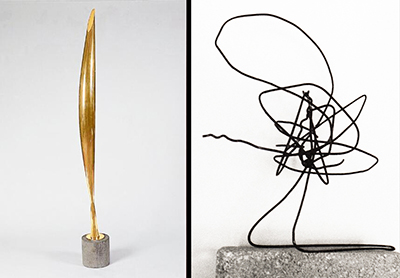 An art exhibit is held at Stanford University, featuring Brancusi's Bird in Space (loaned by student Richard Holkar) as its major piece. Another work entitled Soul in Flight — a "sculpture" consisting of two bent coat hangers — is surreptitiously added to the exhibit by D. Heskett and R. Robbins (student colleagues of Holkar), without the bother of going through the submission process. The coat-hanger piece remains as part of the exhibit for several days, until it is accidentally bumped and comes apart during an evening cleaning of the displays.
An art exhibit is held at Stanford University, featuring Brancusi's Bird in Space (loaned by student Richard Holkar) as its major piece. Another work entitled Soul in Flight — a "sculpture" consisting of two bent coat hangers — is surreptitiously added to the exhibit by D. Heskett and R. Robbins (student colleagues of Holkar), without the bother of going through the submission process. The coat-hanger piece remains as part of the exhibit for several days, until it is accidentally bumped and comes apart during an evening cleaning of the displays.
Congress passes the Civil Rights Act of 1964. The act and this discrimination in all public accommodations and by employers. It also establishes the Equal Opportunity Employment Commission (EEOC) to monitor compliance with the law.


 On June 21, civil rights workers James Chaney, Andrew Goodman, and Michael Schwerner are abducted and killed by terrorists in Mississippi.
On June 21, civil rights workers James Chaney, Andrew Goodman, and Michael Schwerner are abducted and killed by terrorists in Mississippi.
The 24th amendment to the Constitution, which abolishes the poll tax, is ratified.
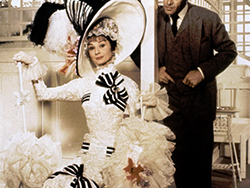 My Fair Lady wins Academy Award for best picture. It was one of the most-anticipated films in years, since it was based on the Broadway mega-hit. The winner of eight Academy Awards, it's also notable as the last best pic winner to be filmed entirely on Hollywood soundstages.
My Fair Lady wins Academy Award for best picture. It was one of the most-anticipated films in years, since it was based on the Broadway mega-hit. The winner of eight Academy Awards, it's also notable as the last best pic winner to be filmed entirely on Hollywood soundstages.
N.H. Field publishes "Fossil sea-echinoids from a Romano-British site" describing the centuries-long occupation of a Romano-British settlement in Dorset. Newer buildings have been built upon older ones, with fossil urchins in each.
Commodore Business Machines (CBM) is founded.
DEC unveils the PDP-8,
Introduction of Wang 300 electronic calculator
Moore's Law coined
1965
 Malcolm X is assassinated at the Audubon Ballroom in Harlem on February 21.
Malcolm X is assassinated at the Audubon Ballroom in Harlem on February 21.
The Watts Uprising occurs on August 11-16th. Thirty-four people are killed and 1000 are injured in the five-day confrontation.
 The Sound of Music wins Academy Award for best picture. A few years after the urban grittiness of West Side Story, Robert Wise directed this wholesome Rodgers & Hammerstein musical. It won five Oscars and was an enormous hit; it also rescued the financially strapped 20th Century Fox, which was recovering from the mega-expensive Cleopatra.
The Sound of Music wins Academy Award for best picture. A few years after the urban grittiness of West Side Story, Robert Wise directed this wholesome Rodgers & Hammerstein musical. It won five Oscars and was an enormous hit; it also rescued the financially strapped 20th Century Fox, which was recovering from the mega-expensive Cleopatra.
Willi Hennig works on a new approach to assessing evolutionary relationships, known as cladistics. Although it will be hotly debated, this technique will eventually become standard practice in paleontology, botany and zoology.
Harry Whittington begins reexamining Burgess Shale fossils originally identified by Charles Walcott starting in 1909. Over the next two decades, Whittington (with the assistance of his graduate students Simon Conway Morris and Derek Briggs), will eventually overturn some of Walcott's theories and propose that most of the animals left no living relatives.
Introduction of DEC PDP-9
The hand-held pocket calculator was invented at Texas Instruments in 1966
1966
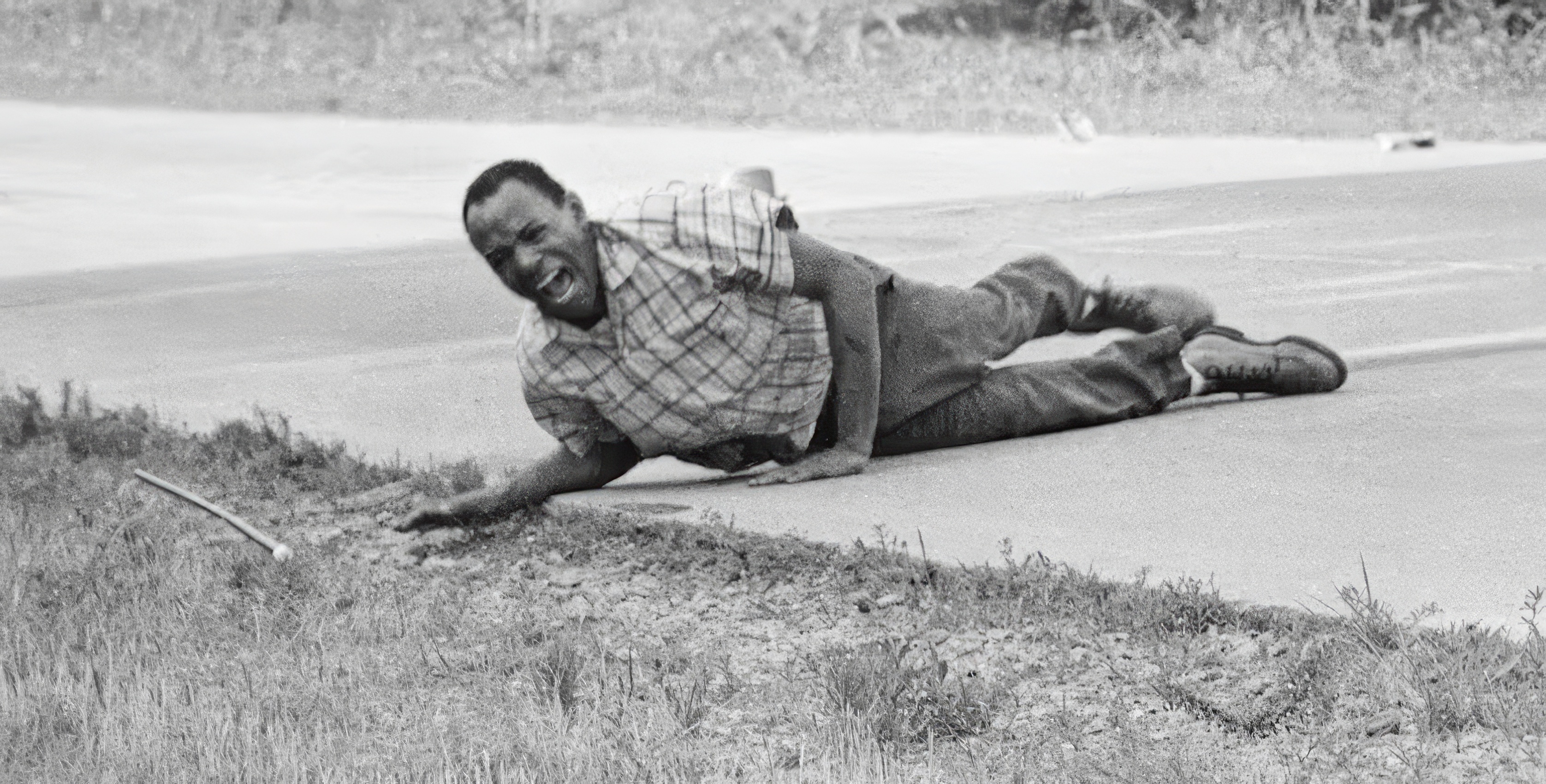 On June 5, James Meredith begins a solitary March Against Fear for 220 miles from Memphis, Tennessee, to Jackson, Mississippi, to protest racial discrimination. Meredith is shot by a sniper soon after crossing into Mississippi.
On June 5, James Meredith begins a solitary March Against Fear for 220 miles from Memphis, Tennessee, to Jackson, Mississippi, to protest racial discrimination. Meredith is shot by a sniper soon after crossing into Mississippi.
 On November 8, Edward Brooke of Massachusetts becomes the first African-American to be elected to the United States Senate since Reconstruction.
On November 8, Edward Brooke of Massachusetts becomes the first African-American to be elected to the United States Senate since Reconstruction.

 On September 15, the Black Panther Party is formed in Oakland, California, by Bobby Seale and Huey P. Newton.
On September 15, the Black Panther Party is formed in Oakland, California, by Bobby Seale and Huey P. Newton.
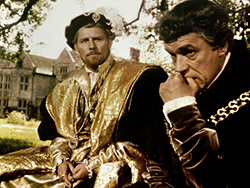 A Man for All Seasons wins Academy Award for best picture. Robert Bolt's thoughtful play, about Sir Thomas More's battles with King Henry VIII, concerned religion, principles, and morality. Bolt adapted his play, which was directed by Fred Zinnemann ( From Here to Eternity ).
A Man for All Seasons wins Academy Award for best picture. Robert Bolt's thoughtful play, about Sir Thomas More's battles with King Henry VIII, concerned religion, principles, and morality. Bolt adapted his play, which was directed by Fred Zinnemann ( From Here to Eternity ).
Lynn Sagan (later Lynn Margulis) hypothesizes that chloroplasts originated as cyanobacteria, and that mitochondria originated as bacteria. She suggests that both were engulfed by other cells and began functioning as symbionts.
Graduate student S.B. Misra discovers a well-preserved sea floor with numerous fossils dating from the late Precambrian (later to be dubbed the Ediacaran Period) at Mistaken Point, Newfoundland.
P. S. Martin suggests that fast-moving bands of human hunters caused the extinctions of Pleistocene big-game species.
Richard Leakey finds two fossil skulls, Omo I and Omo II, in Ethiopia. Though initially dated at 130,000 years, the fossils will later be dated (using argon decay) at 195,000 years, and designated as the oldest examples so far found of Homo sapiens.
Daniel Janzen argues that, because they live under "easy" conditions, tropical plants cannot likely survive a wide range of temperature, light, or hydrologic conditions.
Surgeon General definitively links smoking to lung cancer and presents evidence that it is causing heart problems.
Barclays Bank in the UK claims to have installed the first cash dispenser
Elliott Automation merged with English Electric
Introduction of DEC PDP-10
First MOS 10 by 10 active pixel array shown by Noble
1967
 On July 13, Thurgood Marshall takes his seat as the first African-American justice on the United States Supreme Court.
On July 13, Thurgood Marshall takes his seat as the first African-American justice on the United States Supreme Court.
On June 12, the United States Supreme Court, in Loving vs Virginia, strikes down state interracial marriage bans.
The six-day Newark Riot begins on July 12.
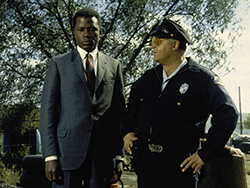 In the Heat of the Night wins Academy Award for best picture. The competition was intense in 1967, including The Graduate and Bonnie & Clyde. But only three years after passage of the Civil Rights Act, this mystery was a look at race relations, exploding prejudices, and offering smart insights. Sidney Poitier and Rod Steiger (best actor winner) led a strong cast.
In the Heat of the Night wins Academy Award for best picture. The competition was intense in 1967, including The Graduate and Bonnie & Clyde. But only three years after passage of the Civil Rights Act, this mystery was a look at race relations, exploding prejudices, and offering smart insights. Sidney Poitier and Rod Steiger (best actor winner) led a strong cast.
A.G. Cairns-Smith publishes a paper suggesting that the first life on Earth might have been fine-grained clay crystals. He will publish on this topic several more times before his death, but the experimental evidence will remain scant, perhaps in part because sufficient technology doesn't yet exist to test the hypothesis.
Richard Fox describes a Paleocene mammal, Prothryptacodon albertensis, retrieved from a well dug in Alberta, Canada. This find eerily resembles that of another Paleocene mammal recovered from a Louisiana oil well and described in 1932 by George Gaylord Simpson.
Teenaged fossil enthusiast Tadashi Suzuki finds a plesiosaur fossil in his hometown of Iwaki City, Japan. The fossil turns out to be a new species, but it won't be identified as such for nearly 40 years.
CDC Introduces the 7600 Supercomputer
Douglas C. Engelbart publicly demonstrates the mouse
IBM tests a 8in floppy disc
Integrated Circuits First Used in Apollo Moon shot
Introduction of HP-9100 desk calculator
Robert Noyce and Gordon Moore found Intel Corporation
T J Watson and IBM granted patent for the DRAM
1968
 On April 4, Martin Luther King, Jr., is assassinated in Memphis, Tennessee. In the wake of the assassination, 125 cities in 29 states experience uprisings.
On April 4, Martin Luther King, Jr., is assassinated in Memphis, Tennessee. In the wake of the assassination, 125 cities in 29 states experience uprisings.
 On June 5, New York Senator and presidential candidate Robert F. Kennedy is assassinated in Los Angeles.
On June 5, New York Senator and presidential candidate Robert F. Kennedy is assassinated in Los Angeles.
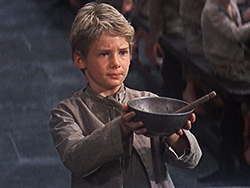 Oliver! wins Academy Award for best picture. The 1960s were NOT the heyday of Hollywood musicals, but you wouldn t know it by looking at Oscar: Oliver! became the fourth musical in eight years to take the best-picture win.
Oliver! wins Academy Award for best picture. The 1960s were NOT the heyday of Hollywood musicals, but you wouldn t know it by looking at Oscar: Oliver! became the fourth musical in eight years to take the best-picture win.
R. H. Whittaker proposes to divide all living things into five kingdoms: Animalia, Plantae, Fungi, Protista and Monera.
Archaeologist Joachim Hahn pieces together the fragments of the lion- headed man found 30 years earlier the Hohlenstein-Stadel Cave in Germany.
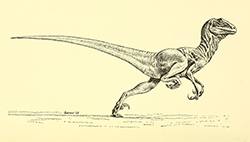 John Ostrom publishes Osteology of Deinonychus antirrhopus, an Unusual Theropod from the Lower Cretaceous of Montana — a description of Deinonychus with a frontispiece illustration by Bob Bakker, suggesting that the dinosaur is alert, agile and intelligent.
John Ostrom publishes Osteology of Deinonychus antirrhopus, an Unusual Theropod from the Lower Cretaceous of Montana — a description of Deinonychus with a frontispiece illustration by Bob Bakker, suggesting that the dinosaur is alert, agile and intelligent.
AMD Advanced Micro Devices is founded
ARPANET launch the world's first successful packet-switched wide area computer network
DEC PDP-15 Introduced
First flight to Moon of Apollo XI with Raytheon Apollo Guidance Computer
Honeywell releases the H316 "Kitchen Computer",
Intel announces a 1 kilobit RAM chip
Plessey buys out Ferranti's numerical Control Interests
Americans land the first man on the moon.
1969
 Richard M. Nixon becomes thirty-seventh president of the United States.
Richard M. Nixon becomes thirty-seventh president of the United States.
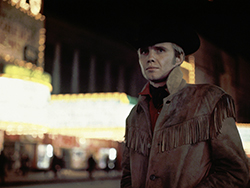 Midnight Cowboy wins Academy Award for best picture. The film, directed by John Schlesinger and starring Jon Voight and Dustin Hoffman, became the first X-rated movie to win the Oscar. When it was re-released two years later, it was re-rated as an R, without any cuts. The script was by Waldo Salt, based on the novel by James Leo Herlihy.
Midnight Cowboy wins Academy Award for best picture. The film, directed by John Schlesinger and starring Jon Voight and Dustin Hoffman, became the first X-rated movie to win the Oscar. When it was re-released two years later, it was re-rated as an R, without any cuts. The script was by Waldo Salt, based on the novel by James Leo Herlihy.
ESP Quick Facts
ESP Origins
In the early 1990's, Robert Robbins was a faculty member at Johns Hopkins, where he directed the informatics core of GDB — the human gene-mapping database of the international human genome project. To share papers with colleagues around the world, he set up a small paper-sharing section on his personal web page. This small project evolved into The Electronic Scholarly Publishing Project.
ESP Support
In 1995, Robbins became the VP/IT of the Fred Hutchinson Cancer Research Center in Seattle, WA. Soon after arriving in Seattle, Robbins secured funding, through the ELSI component of the US Human Genome Project, to create the original ESP.ORG web site, with the formal goal of providing free, world-wide access to the literature of classical genetics.
ESP Rationale
Although the methods of molecular biology can seem almost magical to the uninitiated, the original techniques of classical genetics are readily appreciated by one and all: cross individuals that differ in some inherited trait, collect all of the progeny, score their attributes, and propose mechanisms to explain the patterns of inheritance observed.
ESP Goal
In reading the early works of classical genetics, one is drawn, almost inexorably, into ever more complex models, until molecular explanations begin to seem both necessary and natural. At that point, the tools for understanding genome research are at hand. Assisting readers reach this point was the original goal of The Electronic Scholarly Publishing Project.
ESP Usage
Usage of the site grew rapidly and has remained high. Faculty began to use the site for their assigned readings. Other on-line publishers, ranging from The New York Times to Nature referenced ESP materials in their own publications. Nobel laureates (e.g., Joshua Lederberg) regularly used the site and even wrote to suggest changes and improvements.
ESP Content
When the site began, no journals were making their early content available in digital format. As a result, ESP was obliged to digitize classic literature before it could be made available. For many important papers — such as Mendel's original paper or the first genetic map — ESP had to produce entirely new typeset versions of the works, if they were to be available in a high-quality format.
ESP Help
Early support from the DOE component of the Human Genome Project was critically important for getting the ESP project on a firm foundation. Since that funding ended (nearly 20 years ago), the project has been operated as a purely volunteer effort. Anyone wishing to assist in these efforts should send an email to Robbins.
ESP Plans
With the development of methods for adding typeset side notes to PDF files, the ESP project now plans to add annotated versions of some classical papers to its holdings. We also plan to add new reference and pedagogical material. We have already started providing regularly updated, comprehensive bibliographies to the ESP.ORG site.
ESP Picks from Around the Web (updated 06 MAR 2017 )
Old Science

Weird Science

Treating Disease with Fecal Transplantation
Fossils of miniature humans (hobbits) discovered in Indonesia

Dinosaur tail, complete with feathers, found preserved in amber.
Astronomy

Mysterious fast radio burst (FRB) detected in the distant universe.